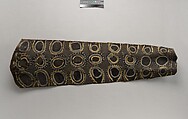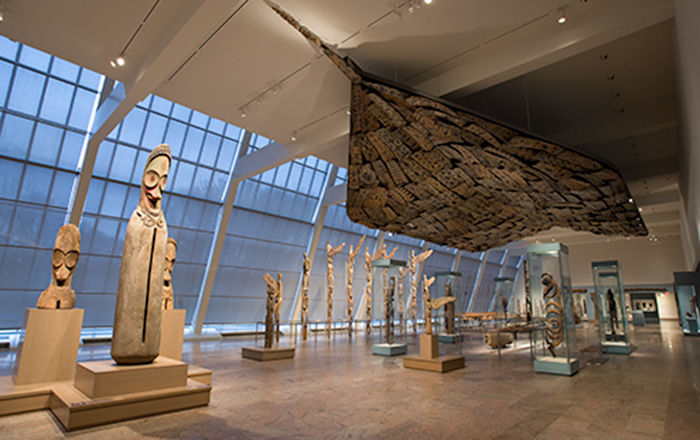Painting from a Ceremonial House Ceiling
Mburrnggei, Amachi-Kalaba
Workshop of Artists of Mariwai Village Papua New Guinea
Not on view
Throughout New Guinea, men’s ceremonial houses were, and in many places still are, the primary focus for painting and sculpture. Like the cathedrals of medieval Europe, they are generally the largest and most sacred buildings in the village, rising high above the ordinary dwellings that surround them. Typically, entry into the ceremonial house is restricted to initiated men, although in some cases, women and children can enter under certain circumstances for specific events. Ceremonial houses serve as the venue for nearly all important male religious rites – such as initiation rites for young boys - and at other times function as meeting houses or informal gathering places. Their structure and the way they are decorated can take on many different local forms and styles.
The Kwoma are a small group of people living in the hills north of the Sepik River in northeast New Guinea. Among the Kwoma people of the Washkuk Hills ceremonial houses have no walls; instead, they consist of a huge steeply pitched roof, which extends nearly to the ground and is supported by a series of massive posts and beams. These structures have no walls and the sides are left open except when rituals are held inside. A finial, carved with images of mythical beings, projects from each gable. Some Kwoma ceremonial houses are unadorned. However, the construction of lavishly decorated examples is a source of pride for the village and its clans. The ceilings of the most ornate ceremonial houses are decorated with hundreds of brilliantly colored paintings and elaborately sculpted posts and rafters.
Paintings are made on sheets of bark or sago petioles, the bark-like bases of the leaves of the sago palm tree, which are trimmed and flattened to create a flat roughly rectangular surface that tapers slightly according to the natural form of the petiole. After a curing process, the artist covers the smooth side of the sheet with a wash of black clay. The main outlines of the design are laid out in clear water, retraced in paint, and then filled in with color. Although one man lays out the design, an assistant may perform the work of infilling and painting the bordering dots. Each painting represents a specific animal, plant, object, supernatural being, or other phenomenon associated with one of the village clans, such as fruit bats or shooting stars for example. The manner in which these clan symbols are depicted varies greatly. Some of the more figurative imagery, such as a relatively naturalistic crocodile, typically do not depict ordinary creatures but rather represent supernatural beings who either are otherworldly animals or have assumed animal form. Many of the paintings employ abstract and geometric designs derived from features of the various animals, plants, and other subjects they portray. Paintings may also include images of natural objects such as the moon in its various phases or legendary figures from the clan’s oral traditions. While there is a fairly well-defined repertoire of specific geometric design types, the meaning of each design can vary according to the intention and clan affiliation of the artist.
When completed, the paintings are tied to the rafters on the underside of the ceiling with lengths of split cane. The panels are arranged lengthwise along the axis of the house, with a few rows placed laterally at its midpoint. The midpoint forms not only the center of the structure--the most ritually important area--but also roughly indicates the sectors allotted to each clan. In general however, there is no prescribed arrangement. Instead the works form a stunning visual patchwork of clan symbols, evoking the strength, unity, and identity of the village clans, whose members gather on the earthen floor beneath them to perform religious rites or initiation ceremonies, hold meetings, or casually socialize.
This panel is one of over 270 original paintings commissioned from Kwoma artists in the village of Mariwai in 1970 and 1973 by Douglas Newton, the first curator of Oceanic art in the Department of the Arts of Africa, Oceania and the Americas. Once completed, they were shipped to New York and installed in the galleries. In 2007, when the Oceania galleries at the Metropolitan Museum were renovated, the panels were attached to a new superstructure. Although less steeply pitched than the Kwoma houses found in villages today, the installation evokes the essential form of a ceremonial house ceiling. Together these suspended panels form an impressive and spectacular installation in the Metropolitan Museum which, at 80.4 feet (24.5 meters) end-to-end, is the largest contemporary art installation in the museum.
This image cannot be enlarged, viewed at full screen, or downloaded.

